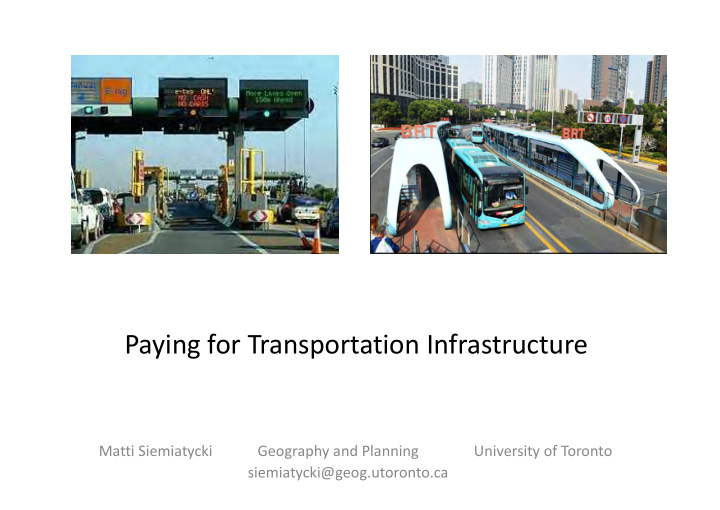



Paying for Transportation Infrastructure Matti Siemiatycki Geography and Planning University of Toronto siemiatycki@geog.utoronto.ca
Two key principles of infrastructure finance 1. Financing and Funding 2. Fund Capital and Operations
1. Paying for Transportation: Financing • Debt • Bonds • Private equity • Hedge Funds • Pension funds/institutional investors • Development bank loans • Each financing sources comes with different risk/return profiles, time horizons, level of active investment, and investment terms and conditions
1. Paying for Urban Transportation: Funding Alternate Revenue sources: No Impact User Fees: Impact on Demand on Demand Property tax • • Transit fares Sales tax • • Road tolls Personal Income tax • Payroll Tax • • Congestion charge Hotel/Recreation Tax • • Parking levies Vehicle Registration fee • • Fuel taxes Land Transfer tax • • Land value capture • Utility bill levy • Are user fees fixed or • Billboard tax variable? • International aid (non repayable) • Grants/ financial support from senior government
Types of Development Bank/Government Financing Support • Direct loans: An infrastructure bank would provide low interest loans directly to governments and/or private project sponsors to finance infrastructure in selected priority areas. The loan would be repaid to the infrastructure bank by the borrower, either from user fees on the facility, or from other general tax revenues collected. • Credit Enhancement : This refers to a variety of measures that improve the chances that loans will be repaid by the borrower. They can be used to encourage lenders to lower interest rates, increase the length of the loan term, or support lending to governments or firms with lower than typical credit profiles. A CIB could offer a variety of credit enhancement services to public and private sector infrastructure project sponsors: Loan Guarantees – Loan loss reserve – Loan loss insurance – Subordinated debt –
Transportation Cost Recovery from Revenues: BRT will likely require government subsidy Roads: Mixed record Transit: Does not recover costs “Rea Vaya’s fare recovery ratio—currently 32 percent—is also far below Latin America’s, where ratios typically range above 80 percent.”
Transport Mega-Projects and Risk: Optimism Biases Mega project risk: By the numbers • Costs 9/10 projects experience a cost overrun • Average size of cost overrun for all project • types is 28% Average overrun for transit projects is 45% • Average overruns of roads is 20% • Demand For 9 out of 10 rail projects, passenger • forecasts were overestimated; the average overestimation is 106%. • Example Rea Valley BRT: • Ridership Estimate – 162,000 – Actual Ridership – 60,000 – Pattern unchanged for 70 years that data is • available
Transportation PPPs: Overview of International Experience
Models of Public-Private Partnerships to Deliver Large Infrastructure Projects Three Key dimensions define PPP 1. Bundle : Which aspects of project delivery are included in the PPP bundle 2. Risk: Which risks are transferred to the private sector (construction; availability; demand) 3. Payment mechanism : How is initial financing repaid (user fees, shadow tolls; availability payments (Source: CCPPP, 2009)
PPP Motivations and Concerns Motivation for PPP Concern with PPP Raise private money to pay for capital More costly than when delivered using costs of infrastructure traditional methods; windfall profits Stimulate innovative project designs Non-competition clauses limit system wide planning and service integration Bring expertise to sectors without local Contractual obligations reduce long-term experience in project delivery or policy flexibility – introduces political risk operations Deliver value for money by transferring High need for data confidentiality can project risks from the public to the private limit meaningful public consultation sector Encourage competition to bring down High frequency of contract project costs and improve efficiency renegotiations, often benefiting contractor
Are PPPs Value for Money? 10000 9000 Value for Money 885 (11%) 8000 810 3266 228 7000 Net Cost ($ Millions) 6000 106 5000 4000 6950 3000 5501 2000 1000 0 Traditional Procurement PPP Base Cost (Including Financing Costs) Transaction Costs Retained Risks
Demand Risk Transfer: Long-Term Experience with Early Transit PPPs Unsuccessful ‘allocating all demand risk to private operators has a poor track record’ World Bank, 2010
New Risk Allocations Making Transit PPPs More Viable
Integrating Transportation and Land Use into PPP?
Conclusions: Setting the conditions for Successful Sustainable Transit PPPs 1. PPP works best when government maintains control over long term planning, with flexibility to make changes over time Conflicts between partners arise when contracts – are inflexible to change Demand risk likely shared rather than transferred – 2. Contract must be structured to ensure seamless integration between public and private system: user should not be able to tell the difference 3. Governments on same page at outset to limit jurisdictional disputes Costs of competing visions can be magnified due – to contracts with private sector partner Conflicting public policy can limit viability of the – concessionaire or cause legal disputes 1. Ensure complementary land use development is part of the upfront planning process, and is consistent with the PPP structure
Communicating transport plans and building local support
Recommend
More recommend